Presynaptic terminals independently regulate synaptic clustering and autophagy of GABAA receptors in Caenorhabditis elegans
- PMID: 16467519
- PMCID: PMC6793639
- DOI: 10.1523/JNEUROSCI.2279-05.2006
Presynaptic terminals independently regulate synaptic clustering and autophagy of GABAA receptors in Caenorhabditis elegans
Abstract
Synaptic clustering of GABAA receptors is important for the function of inhibitory synapses, influencing synapse strength and, consequently, the balance of excitation and inhibition in the brain. Presynaptic terminals are known to induce GABAA receptor clustering during synaptogenesis, but the mechanisms of cluster formation and maintenance are not known. To study how presynaptic neurons direct the formation of GABAA receptor clusters, we have investigated GABAA receptor localization in postsynaptic cells that fail to receive presynaptic contacts in Caenorhabditis elegans. Postsynaptic muscles in C. elegans receive acetylcholine and GABA motor innervation, and GABAA receptors cluster opposite GABA terminals. Selective loss of GABA inputs caused GABAA receptors to be diffusely distributed at or near the muscle cell surface, confirming that GABA presynaptic terminals induce GABAA receptor clustering. In contrast, selective loss of acetylcholine innervation had no effect on GABAA receptor localization. However, loss of both GABA and acetylcholine inputs together caused GABAA receptors to traffic to intracellular autophagosomes. Autophagosomes normally transport bulk cytoplasm to the lysosome for degradation. However, we show that GABAA receptors traffic to autophagosomes after endocytic removal from the cell surface and that acetylcholine receptors in the same cells do not traffic to autophagosomes. Thus, autophagy can degrade cell-surface receptors and can do so selectively. Our results show that presynaptic terminals induce GABAA receptor clustering by independently controlling synaptic localization and surface stability of GABAA receptors. They also demonstrate a novel function for autophagy in GABAA receptor degradative trafficking.
Figures
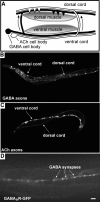

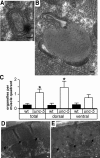
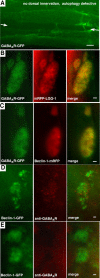

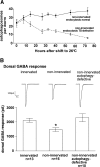
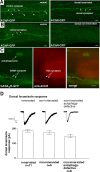
References
-
- Ackerman SL, Kozak LP, Przyborski SA, Rund LA, Boyer BB, Knowles BB (1997). The mouse rostral cerebellar malformation gene encodes an UNC-5-like protein. Nature 386:838–842. - PubMed
-
- Baulac S, Huberfeld G, Gourfinkel-An I, Mitropoulou G, Beranger A, Prud’homme JF, Baulac M, Brice A, Bruzzone R, LeGuern E (2001). First genetic evidence of GABAA receptor dysfunction in epilepsy: a mutation in the gamma2-subunit gene. Nat Genet 28:46–48. - PubMed
-
- Bettinger JC, Lee K, Rougvie AE (1996). Stage-specific accumulation of the terminal differentiation factor LIN-29 during Caenorhabditis elegans development. Development 122:2517–2527. - PubMed
Publication types
MeSH terms
Substances
Grants and funding
LinkOut - more resources
Full Text Sources
Research Materials
